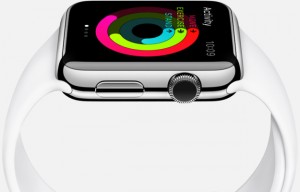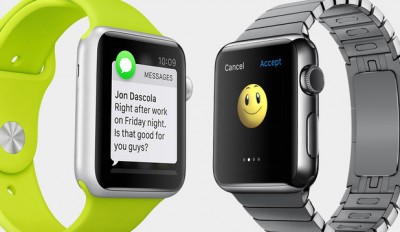Apparently, Apple’s CEO Tim Cook now says that the Apple Watch will ship in April. This slippery release date has, in Mr. Cook’s own words at various times, gone from “early 2015” to March, and now April. Would it surprise anyone if it slipped further to May or June?
Sure, the sliding release date whets the appetite even further of those who were keen right from the start to get their hands on one. But that’s not why the release date keeps getting pushed back. Apple says, and there’s no reason to doubt them, that they are still trying to make sure the device is as good and problem free as it can be.
Maybe we need a little reminder about what exactly the Apple Watch is, and why we are so eagerly anticipating it.
The Apple Watch Is the Latest in the Line of the Brand’s Pioneering Products
 First and foremost, it is the first offering in a new category from a company that has pioneered new categories throughout its history. From the iMac to the iPod to the iPhone, Apple has distinguished itself by creating original, top quality new devices that become the industry standard for others to follow. That is why people who have absolutely no interest in having a smartwatch are still interested in the Apple Watch.
First and foremost, it is the first offering in a new category from a company that has pioneered new categories throughout its history. From the iMac to the iPod to the iPhone, Apple has distinguished itself by creating original, top quality new devices that become the industry standard for others to follow. That is why people who have absolutely no interest in having a smartwatch are still interested in the Apple Watch.
What we do know about the Apple Watch so far, is that it certainly fits the bill for originality. The Apple Watch promises to deliver things that we haven’t seen before in the smartwatch business.
Original Features of the Apple Watch
The device is controlled what Apple calls the “Digital Crown”, which, to the uninitiated, looks a lot like the winding mechanism on a standard analog watch.The “Digital Crown” lets you scroll and browse through the entire user interface of the Apple Watch, instead of frantically swiping or holding clunky buttons like you would have to do with other smartwatches in order to achieve the same results. A form and function winner.
 Unlike any other smartwatch, the Apple Watch touchscreen is able to detect the difference between a touch and a press, allowing the user to open up further settings and menus. Menus are made up of “Glances”, that distill first and third-part apps into simple, easy to-read tasks and instructions.
Unlike any other smartwatch, the Apple Watch touchscreen is able to detect the difference between a touch and a press, allowing the user to open up further settings and menus. Menus are made up of “Glances”, that distill first and third-part apps into simple, easy to-read tasks and instructions.
For example, you can control music from your Apple Watch on your iPhone, or you can listen to music stored locally on the device by using the same “Glance”. Calendars, maps, messages and every other app all has its own “Glance”.
All of these functions are wrapped into what Apple calls the ‘Taptic Engine”, a small, vibrating unit built right into the device that provides notifications without disturbing others. These kinds of vibrations are’t unique to the Apple Watch , but what is unique is the ability to raise the watch towards you while the Apple Watch intelligently analyses the notifications, allowing you to interact with them more easily on the watch display.
Take these original features and more like them, and you’ve got a pretty original device. But the “make it or break it” capabilities of the Apple Watch lie in a number of high-quality apps, most of which we don’t know about yet. You can be sure that many corporations and organizations are developing apps to take advantage of the “Apple Pay” or user ID capabilities so that we can easily buy coffee, board a plane, enter concerts, etc.
The Apple Watch Has Cons, and Then There’s The “It” Factor
Of course, none of this suggests that there aren’t serious questions marks about the Apple Watch. The battery life has always been and remains a dubious proposition, and if the device runs out of juice during a normal day of usage, then that could be a deal breaker right there.
Then there’s the matter of the device’s necessity in the first place. Since it requires a companion iPhone in order to operate, does it really deliver enough utility on its own? Do we really want to spend $350 for a “remote control for your phone”? The answer to that depends on a lot of things, from the quality of the apps to each individual user’s inclination towards digital gadgetry.
In the final analysis, Apple is counting on people’s reactions to actually seeing one of these high-quality devices in person. Venture Beat’s Mark Sullivan said he felt pretty “meh” about the Apple Watch until he saw one in real life on an Apple employee. This was his reaction:
I want one, and I didn’t even really see much of what the thing could do. But I got the distinct impression that the Watch has already become integrated into the daily life of this user. I could see it as a powerful personal assistant that’s always just an arm’s lift away to help you make sense of the minutiae of daily life: the schedules and reminders and appointments and social media and everything else we all have to process every minute of every day.
It will get worse. The Watch will launch with just a limited set of features, and at first, it will seem like merely a remote control for your phone. But later on the Watch will start to do more and more things — some of them completely independent of the phone. Next thing you know, you’ll see people using the Watch to buy coffee at Starbucks, or scan to get on the train, or check in for a flight, or produce one’s medical records at the doctor’s office.
Apple will, of course, nail the marketing of the Watch. We’ll see all sorts of images of cool people doing cool things with the cool device. The fashion industry will embrace it.
However, the most compelling advertisement for the Watch will be the sight of real people using it to do practical things in real life.
We’re talking about the “it” factor. If anyone knows how to deliver the ‘it” factor, it is Apple. Do you know for sure that you won’t react the same way when you finally see your first Apple Watch?
